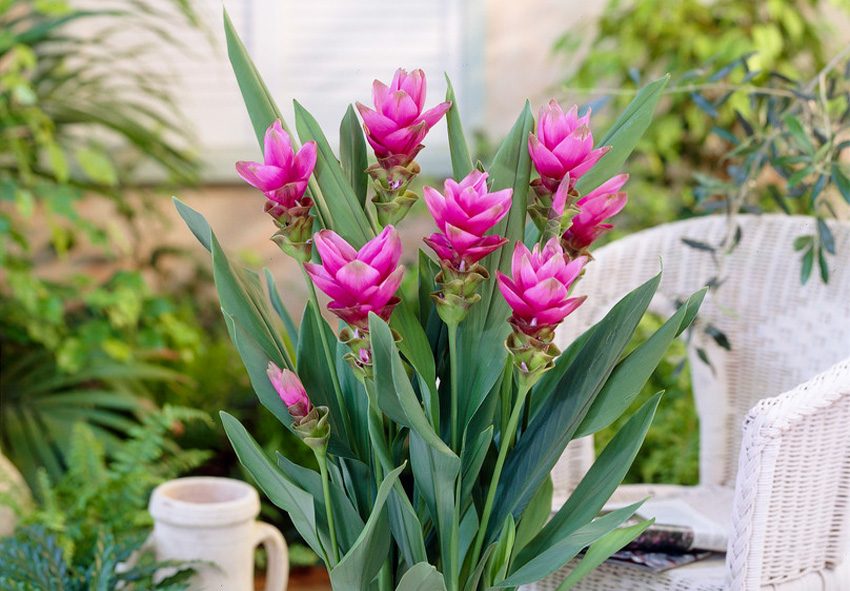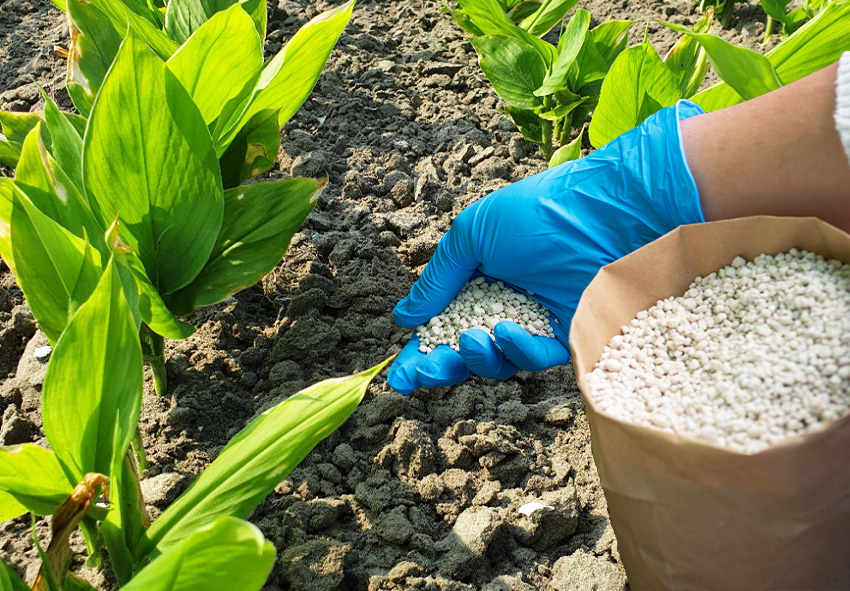Curcuma is a genus of tropical plants that includes both ornamental species like the vibrant Siam tulip and edible varieties like Curcuma longa, also known as turmeric. These stunning plants are admired for their colorful bracts and lush foliage, making them ideal for gardens and containers alike. In this complete guide, you’ll learn how to care for Curcuma — from choosing the right conditions to seasonal maintenance and propagation—for thriving plants and successful blooms. Our gardening blog is a perfect place to find all the information you need!
What Is Curcuma?

Curcuma is a tropical genus in the ginger family (Zingiberaceae), native to South and Southeast Asia. Popular species include Curcuma longa, prized for its edible turmeric rhizomes, and Curcuma alismatifolia, known for its decorative flowers. While edible Curcuma is grown mainly for harvest, ornamental varieties offer bright, tulip-like bracts that enhance any landscape.
How to Grow Curcuma Plants
Growing Curcuma successfully starts with selecting the right environment and planting technique. These tropical beauties thrive in warm, humid conditions and reward the gardener with both visual appeal and, in some cases, culinary benefits.
- Light and Temperature Requirements
Curcuma plants prefer partial shade or filtered sunlight. They should receive around 4–6 hours of light per day, ideally protected from intense afternoon sun. Since Curcuma is frost-sensitive, temperatures should stay above 60°F (15°C) for consistent growth.
- Soil and Potting Needs
The ideal soil for Curcuma is well-drained, fertile, and slightly sandy or loamy. When planting outdoors or in containers, ensure good drainage to avoid rhizome rot. Raised beds or pots with drainage holes are excellent choices for Curcuma cultivation.
Watering and Feeding Curcuma
Proper hydration and nutrition are key to maintaining strong Curcuma plants. Whether you’re growing turmeric or ornamental varieties, balanced watering and feeding schedules will encourage vibrant foliage and long-lasting flowers.
Turmeric Plant Watering Tips
During active growth (spring to early fall), keep the soil consistently moist but not soggy. Reduce watering during dormancy, usually in winter, to prevent rhizome rot. Signs of overwatering include yellowing leaves and mushy roots.
Fertilizer Needs and Schedule
To keep your Curcuma plants healthy and thriving, a consistent and well-balanced feeding routine is essential. Whether you’re growing ornamental varieties like Siam tulips or edible turmeric, applying the right fertilizer at the right time will enhance foliage, flower production, and rhizome development. Here’s a helpful list to guide your feeding schedule:
- Start with a balanced fertilizer in spring: As new growth emerges, use a balanced fertilizer (such as 10-10-10) to support overall plant health and vigor.
- Apply phosphorus-rich fertilizer during blooming: When flower buds appear, switch to a bloom-boosting fertilizer high in phosphorus to enhance flowering.
- Feed every 4–6 weeks during the growing season: Consistent feeding from spring through early fall encourages steady growth and vibrant blooms.
- Stop fertilizing in late fall: Cease feeding as the plant enters dormancy; continued fertilization during this period can harm rhizomes.
- Use slow-release or liquid fertilizer depending on your setup: Container-grown plants may benefit from liquid feed, while in-ground plants do well with slow-release granules.
Seasonal Maintenance for Curcuma

Curcuma has a distinct growth cycle, flourishing in the warmer months and going dormant in winter. Understanding this cycle helps you plan proper care routines to keep the plant healthy year after year.
Summer Growth and Flowering Care
During the growing season, keep the soil evenly moist and apply a layer of mulch to retain moisture and suppress weeds. Remove spent flowers to encourage further blooming and maintain a tidy appearance. Provide some protection from strong winds or heavy rain to preserve the ornamental bracts.
Winter Dormancy Care
As temperatures drop and foliage dies back, reduce watering and stop fertilizing. In colder climates, dig up the rhizomes before the first frost, let them dry for a few days, then store them in a cool, dry place in peat moss or vermiculite. In warmer zones, mulch heavily and leave the rhizomes in the ground.
Propagation and Division
Propagating Curcuma is a great way to expand your collection or share plants with others. This is typically done by dividing mature rhizomes during dormancy.
How to Divide Curcuma Rhizomes
Divide Curcuma in late winter or early spring before new growth appears. Use a clean, sharp knife to cut the rhizomes into sections, making sure each piece has at least one growth node. Allow cut surfaces to dry for a day before planting.
Starting Curcuma from Rhizomes
Plant rhizomes horizontally in pots or beds, about 2–3 inches deep with the bud side facing up. Keep the soil warm and moist until shoots appear, typically in 2–4 weeks. Provide indirect light and protect young shoots from sudden temperature changes.
Edible Use of Curcuma longa (Turmeric)

Curcuma longa, commonly known as turmeric, is not only a beautiful plant but also a prized spice known for its vibrant color and health benefits. Growing your own turmeric at home allows you to enjoy fresh, organic rhizomes that can be used in cooking, teas, or health remedies. Here’s a list to help you make the most of turmeric’s edible potential:
- Grow turmeric in warm, humid conditions: Turmeric thrives in tropical-like environments. Plant the rhizomes in late spring or early summer when soil temperatures consistently reach 20–30°C (68–86°F).
- Use rich, well-draining soil: To promote large, healthy rhizomes, grow turmeric in loose, fertile soil enriched with compost or organic matter.
- Harvest after 8–10 months of growth: When the foliage begins to yellow and die back, it’s time to dig up the rhizomes. This usually occurs in late fall.
- Clean and cure rhizomes before use: After harvesting, wash the rhizomes thoroughly and let them dry in a warm, shady spot for about a week to cure and enhance flavor.
- Store properly for culinary use: Keep fresh rhizomes in a cool, dry place or refrigerate them. You can also boil, peel, and dry them for long-term storage or grinding into turmeric powder.
Conclusion
Caring for Curcuma plants, whether ornamental or edible, is a rewarding experience for gardeners of all levels. With the right light, water, soil, and seasonal care, your Curcuma will produce stunning foliage and flowers — or flavorful turmeric rhizomes. Explore our online store to find high-quality Curcuma bulbs and start growing these beautiful tropical plants in your garden today.
Frequently Asked Questions (FAQs) about Growing Curcuma
1. Can Curcuma grow indoors?
Yes, Curcuma can be grown indoors as long as it receives bright, indirect light and is kept in a warm, humid environment. Use a well-draining potting mix and avoid overwatering, especially during its dormant season in winter.
2. When should I dig up and store Curcuma rhizomes?
In colder climates, dig up the rhizomes after the foliage dies back in fall. Let them dry for a few days, then store in a cool, dark place in dry peat moss or vermiculite until spring planting.
3. Can I order Dutch Curcuma from your online store?
Yes, you can order a variety of Curcuma plants, including ornamental types like Siam tulips and edible turmeric, from our online store Dutch-bulbs.com. We offer high-quality rhizomes directly from Holland that are ready for planting.
4. What is the best fertilizer for Curcuma plants?
Use a balanced liquid fertilizer or one slightly higher in phosphorus to support healthy growth and flowering. Feed monthly during the growing season and stop once dormancy begins.
5. How do I encourage Curcuma to bloom?
Ensure the plant receives partial sun, warm temperatures, and consistent moisture. Fertilize monthly during the growing season and avoid disturbing the roots too often to promote flowering.
Published: 23.05.2025
